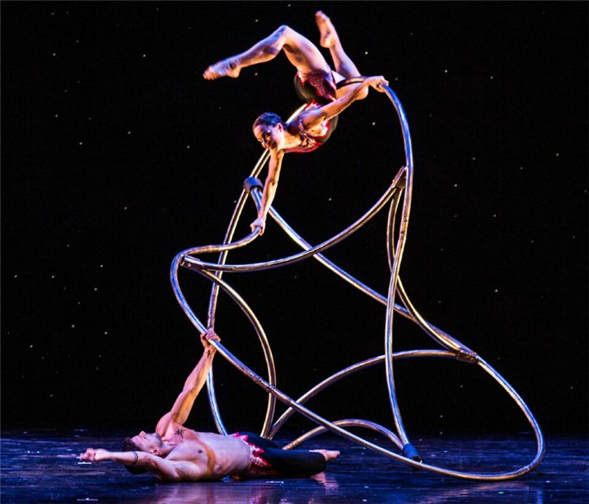Translate Page

Two veteran company members on working for visionary choreographer Moses Pendleton
---
The mesmerizing and fantastical visuals conjured by Momix come directly from founder Moses Pendleton's expansive imagination. Aided by artful lighting and projections, the company of "dancer-illusionists" transforms into eye-popping flora and fauna, evoking a Southwestern desert scene one minute and a lunar landscape the next. The venerable troupe's three-week summer season at the Joyce includes sections from several well-loved full-length pieces (Opus Cactus, Lunar Sea, Botanica and Alchemia), plus three New York premieres: Daddy Long Leg, Light Reins and Paper Trails.
Sly and unpredictable, Pendleton acknowledges that the pieces he's created during Momix's 38 years call for unusual skills. Because he often integrates props into his work, his dancers "have to be able to be very versatile with their arms -- almost like puppeteers," he says. He also values an interest in nature, since that's what sparks many of his ideas. But the most important criteria is "the ability to laugh at their director's jokes," he says, chuckling. "You need a sense of humor to be in Momix."
So what sort of background do most of his dancers have? It varies -- a lot. "There's no Momix school, so you really learn on the spot," says Jennifer Chicheportiche, who's been with the company for 11 years. "Everybody takes the ballet barre. But we all come from mixed backgrounds and he really uses that in his creations. And the dancers are transformed from performing his work."
{Image2}
"I think Moses looks for something in someone that excites him," says Jason Williams, who joined the troupe in 2011. "He looks for someone who's going to entice him to create."
Born in France, Chicheportiche trained in the classical Russian Vaganova method, and spent several years performing with European contemporary ballet companies. During that time, she saw a Momix performance. "I loved it but I thought, that's for gymnasts," she recalls. "I could not see myself in the company at all."
Yet when she arrived in New York to check out the dance scene, she decided to attend a Momix audition. "I did a lot of improv, but using my ballet technique," she says. "I had a lot of energy and I was really into it. They liked that."
Williams heard about Momix from a guest choreographer during his senior year at Miami's New World School of the Arts. Since he was studying modern dance, he was considering auditioning for Paul Taylor, Martha Graham or José Limón. But when he looked up Momix online, "I was just enthralled," he recalls. "It was magic to my eyes. So I went to the audition and it was a blast -- a lot of improvisation. It was fun to be with that creative mindset."
Both Chicheportiche and Williams admit they faced many challenges learning Momix's repertoire. Williams recalls the time and effort it took to master Dreamcatcher, a duet performed on a rocking metal sculpture that frequently places the dancers in gravity-defying positions. "It was physically and mentally exhausting," he says. "I learned it from a guy who'd been doing it for 12 years, so he was on autopilot. But I was banging my head, and the sculpture rolled over my chest."
{Image1}
Chicheportiche cites the solo Aqua Flora, in which she uses different parts of her body to continuously twirl a large beaded prop, as her most difficult dance. "I've been doing it a really long time, but it's always hard," she says. "I'm responsible for keeping that spin going to the end. That's the most challenging piece in terms of endurance that I have in the show."
This fall, Pendleton is gearing up to create a brand-new full-length work. Getting a chance to be part of his creative process is a big reason Chicheportiche, Williams and the other Momix dancers love being part of the singular company.
"Whoever is in it will have a huge input into what the show will look like," says Chicheportiche. "He likes that -- his inspiration comes from us."
---
Susan Reiter regularly covers dance for TDF Stages.
Top image: Heather Magee Spilka and Jason Williams in Dreamcatcher. Photo by Max Pucciarello.
TDF Members: Go here to browse our latest discounts for dance, theatre, and concerts.